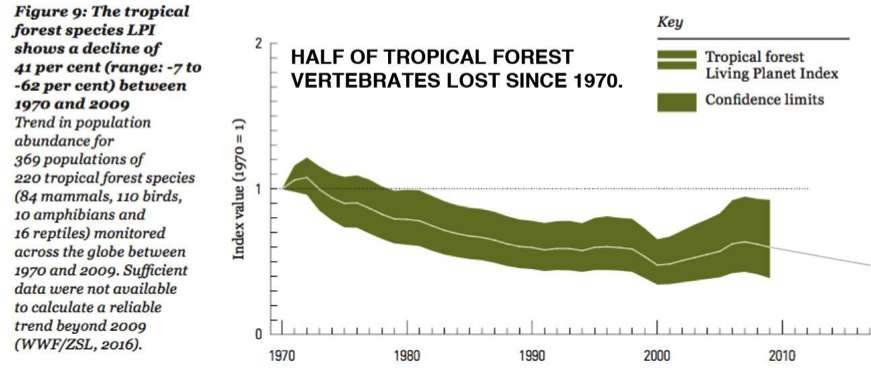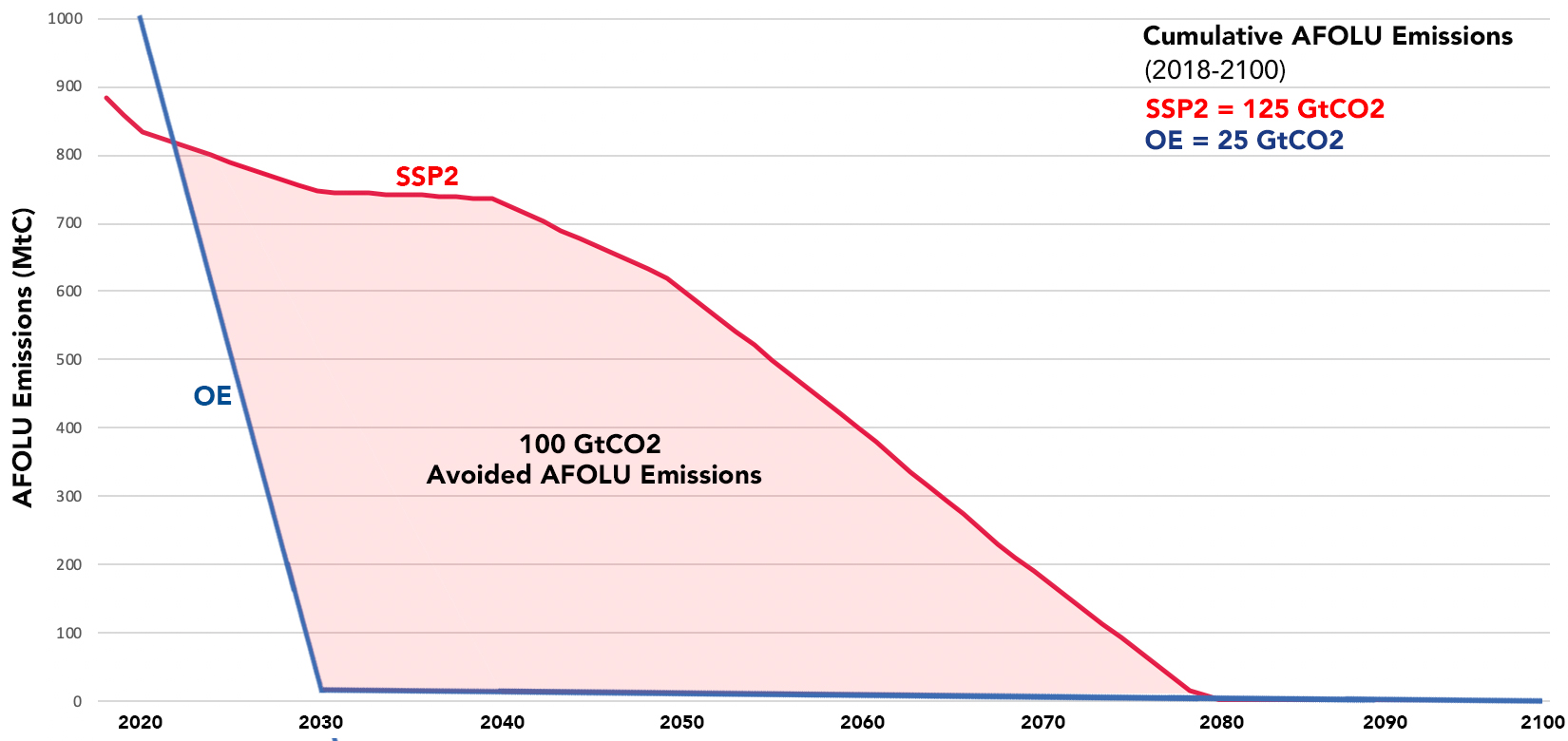Protecting 50% of our Lands and Oceans
Tigers, elephants, wolves, and whales do not often figure into international climate negotiations, but they should. These critical species manage vast and complex ecosystems, and when those ecosystems are healthy they absorb a lot of carbon. A recent study has shown that landscapes in Nepal with wild tigers contain 3x more carbon than non-wild landscapes in the region. And no-take marine reserves have been shown to increase fish populations by a factor of 7.6x, resulting in an abundance of sea life, bigger catches for adjoining fisheries, and increased carbon sequestration in the oceans. One Earth places conservation at the heart of the solution, strengthening the ability of the biosphere to absorb more carbon and rebalance our global climate system.
In 2015 phytoplankton in the ocean, trees and other plants absorbed about 20 Gt of anthropogenic CO2 emissions, or roughly half of our annual total. Without the benefit of these functioning ecosystems, we would be doubling the amount of carbon pollution entering the atmosphere annually, almost certainly locking in catastrophic climate change. In the IPCC's 5th Assessment Report (AR5) -- the scientific consensus behind the Paris Agreement -- it is a tacit assumption in all the climate models that nature will continue providing this life-saving service to us. But is that true?
In reality the ecosystems that balance our climate and make life on Earth possible are under threat. Despite some progress, a sobering report by Taubert et al. (2018) shows that tropical forests, which store most of the world’s carbon, are nearing a breaking point. We continue to develop, deforest, and degrade our lands while pillaging and polluting our seas as if there will be no consequence. The dots are not being connected except by a few in academic circles.
We are losing our rainforests at an alarming rate, the equivalent of one football field every second, with 2018 seeing a record-setting spike in deforestation in the Amazon. Oceans have also been hit hard. One-third of the world’s coral have died and another third are expected to perish by 2030, threatening global fisheries. Climate change is only adding fuel to the fire, with rapidly increasing global temperatures wreaking havoc on the delicate balance that has allowed life to flourish since the end of the last ice age.
Forest landscapes, covering 31% of the world's land surface (just over 4 billion hectares) contain the highest concentration of both biodiversity and carbon. Of that, only about one-quarter are still considered to be intact forest landscapes (IFLs). These areas can be found mostly in Canada, Russia, and Brazil. Only 19% of IFLs are under some form of protection and 10% are strictly protected. Tropical forests are the most biodiverse of all landscapes. While covering only 15% of the global land area, they contain over half of all animal and plant species and store one-quarter of the world’s carbon. These forests have been hit the hardest. Since 1990, Indonesia has lost 50% of its original forest, the Amazon 30%, and Central Africa 14%.
Perhaps most sobering is the unfathomable loss of life on the planet. According to the Living Planet Report (2018) since 1970 we lost 60% of the world’s vertebrate populations and 80% of freshwater populations. This has led many to say we have now entered the sixth mass extinction event.

It’s clear that the wellbeing of both humanity and the millions of species that depend upon the forests and other intact ecosystems are intertwined. But why protect half of the world’s lands?
The answer is simple.. because that is all that is left.
A new study by Kennedy et al. 2018 shows that only 49% of the world’s lands remain in a relatively intact state. If you subtract the solid ice portion of Greenland (1.4M km2 accounting for a 50m buffer to coastal tundra) and regions that receive less than 1” rainfall per year in the Sahara desert (2.3M km2 accounting for a 50m buffer to major geological features and existing protected areas) the figure goes down to 46% (see below). The remaining green areas in the map depict the terrestrial “sponge” that absorbs approximately one-quarter of our annual CO2 emissions. Tropical forests absorb the lion’s share of this carbon. Yet, since 1970 we have lost nearly one-third of this terrestrial carbon sink, just as we have tripled our global CO2 emissions.
So the math is simple: we must protect all remaining intact ecosystems to ensure the continued functioning of the terrestrial carbon sink.

Least modified lands per Kennedy et al. 2018
That is the baseline, but we need to do more. We also need to restore as much land as possible, to achieve negative emissions necessary for a 67% chance of achieving the 1.5˚C target. A recent analysis derived from “Natural Climate Solutions” by Griscom et al. (2017) identifies approximately 800 Mha of degraded lands that are suitable for ecological restoration. Taking just a portion of this potential we could expand the world’s natural lands by 2-3M km2 (approximately 2% of additional lands), delivering 175 GtCO2 in negative emissions through 2100. Rewilding of existing natural forests and improving conditions of managed forests will deliver an additional 200 GtCO2 in negative emissions.
That takes the total to 48% of land area for the global carbon sink. For the Global Safety Net (see below) an additional 2% of land area is added through a network of corridors linking together the world’s intact lands, helping ecosystems and terrestrial carbon sinks to be more resilient to the impacts of climate change.

A rapid phaseout of deforestation by 2030 identified in the One Earth climate mitigation scenario could avoid as much as 100 GtCO2 AFOLU emissions versus the IPCC's second Shared Socioeconomic Pathway (SSP2), which models a gradual decline in deforestation and other land use change emissions to zero in 2080. Image credit: Karl Burkart, One Earth
Ocean conservation is also key to ensuring the vitality of the world’s carbon sinks. 83% of the global carbon cycle is circulated through the ocean. Coastal habitats cover less than 20% of the total ocean area, but account for approximately half of the total carbon sequestered in ocean sediments (aka “blue carbon”). Of an estimated 300 GtCO2 of marine carbon sequestration in the 1.5C model, approximately 180 GtCO2 is attributed to coastal ecosystems and another 120 GtCO2 in the high seas.
Coastal ecosystems cover only 55% of the ocean area defined by the world’s exclusive economic zones (EEZs). EEZs cover 36% of total ocean area, 45% of which is non-coastal, or 16% of total ocean area. Non-coastal seas cover 80% of total ocean area, so EEZs account for a full 60% of carbon sequestered in ocean sediments.
_resized.jpg)
Mangrove forest in Mexico. Image credit: Daniel Eynis, Creative Commons
For the marine realm, the capacity of the oceans to sequester carbon will decline during the century as emissions are reduced, but we can ensure that oceans rebound and stay healthy and vibrant through a 50% marine conservation target, which will be explored in greater detail through the Global Safety Net project.
Explore the Global Safety Net_resized.jpg?auto=compress%2Cformat&w=1440)


